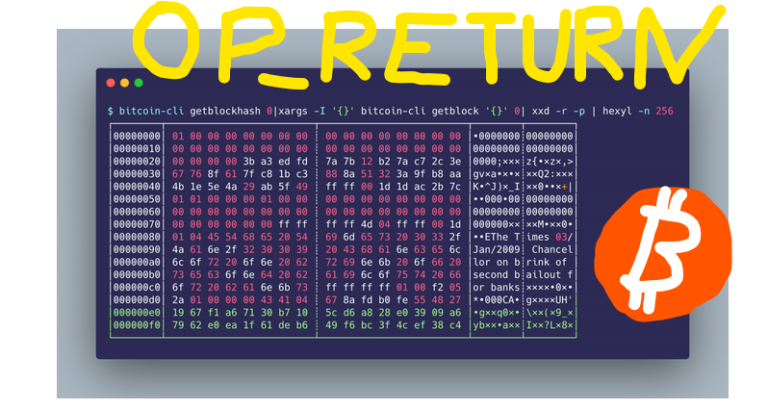OP_RETURN Bitcoin: Understanding Its Impact on Transactions

OP_RETURN Bitcoin has emerged as a critical element within the sphere of Bitcoin scripting, allowing users to seamlessly embed non-spendable data directly into their Bitcoin transactions. This innovative opcode, introduced in Bitcoin Core, not only facilitates efficient data storage but also provokes important discussions regarding the future of Bitcoin as both a payment system and a data carrier. Currently, the OP_RETURN limit restricts users to embed only 80 bytes of data, igniting debate among enthusiasts about the necessity of this constraint. Nevertheless, OP_RETURN Bitcoin significantly enhances the functionality of transactions, providing opportunities for various applications that extend far beyond mere monetary exchanges. As blockchain innovations continue to evolve, understanding OP_RETURN and its implications for Bitcoin data storage will be essential for anyone involved in the cryptocurrency landscape.
The functionality known commonly as OP_RETURN Bitcoin represents a powerful facet of Bitcoin’s programming capabilities, allowing for the integration of unspendable data in transactions. This opcode serves as a tool for users to introduce slight data inserts, which has applications that go beyond traditional currency exchange to include essential metadata and various protocols. By permitting a limited quantity of information to be embedded directly into the blockchain, it strikes a delicate balance between network efficiency and the preservation of necessary data. As proponents and critics of OP_RETURN engage in ongoing discussions, the implications of such data storage techniques raise pertinent questions about the future of Bitcoin and its potential to adapt to the demands of both innovation and transaction efficiency.
The Significance of OP_RETURN in Bitcoin Transactions
OP_RETURN plays a crucial role in Bitcoin transactions, as it enables users to embed metadata and other non-financial information directly into the blockchain. This feature allows for new use cases beyond traditional payments, such as registration of digital assets and timestamping of ownership proofs. Its introduction marked a pivotal moment in Bitcoin scripting, showcasing the flexibility of Bitcoin as a platform for innovative applications. By facilitating data storage in a manner that prevents bloating of the UTXO set, OP_RETURN supports a more efficient network while opening avenues for developers to explore beyond simple currency exchange.
Critics might argue that by allowing small amounts of extra information in transactions, OP_RETURN diverts Bitcoin from its primary purpose, but many proponents believe that these non-spendable outputs enhance the capabilities of Bitcoin without compromising its core functions. The ongoing discussions within the community reflect a tension between preserving Bitcoin’s original vision as a decentralized currency and embracing its potential as a broader platform for innovation.
Exploring the Proposed Changes to OP_RETURN Limit
The proposal to remove the 80-byte limit on OP_RETURN outputs has ignited discussions among Bitcoin developers and enthusiasts alike. Advocates argue that the current restriction is an outdated remnant that hinders growth and creativity in the Bitcoin ecosystem. By lifting this cap, transactions could accommodate larger data embeds, providing developers with more flexibility. This development aligns with existing practices where some services already manage data-heavy transactions, highlighting an emergent need for standards that better reflect the current landscape of Bitcoin usage.
While many embrace the idea of increased capacity for OP_RETURN entries, there are concerns about the potential negative impact on Bitcoin’s network efficiency. Detractors worry that obtaining large amounts of data in transactions could lead to congestion and a spike in transaction fees. They caution that increased data storage capabilities could detract from Bitcoin’s essential characteristic as a payment network, thereby fueling a debate that balances innovation and network sustainability. Maintaining clear governance policies in such rapid changes is crucial for the community to navigate future developments in Bitcoin.
The Role of OP_RETURN in Layer-Two Innovations
OP_RETURN has emerged as a significant tool for layer-two innovations on the Bitcoin blockchain, allowing for the embedding of non-financial data that enhances various applications. Notably, this opcode supports projects that utilize zero-knowledge proofs and decentralized exchanges, fostering an environment where digital assets can thrive securely. By enabling the documentation of contractual terms and their proof without placing the entire network at risk of overload, OP_RETURN leads the way for future developments that retain Bitcoin’s foundational principles while encouraging innovation.
Furthermore, the integration of OP_RETURN with layer-two protocols allows developers to build on Bitcoin’s strengths while minimizing potential drawbacks such as increased transaction times and fees. The focus on developing methods that streamline usage and promote efficient data handling within the Bitcoin network showcases the community’s commitment to expansion while remaining faithful to the core philosophy of decentralization and security. Each use case for OP_RETURN promotes a deeper exploration of Bitcoin’s capabilities beyond simple transactions, paving the way for a vibrant ecosystem.
Navigating Governance and Community Trust in Bitcoin
As proposals for changes to the OP_RETURN limit evolve, the discussion emphasizes the importance of governance and community trust within the Bitcoin ecosystem. Some node operators advocate for solutions that respect classic monetary functions while also embracing the opportunities presented by innovative features like OP_RETURN. The differing opinions demonstrate a robust democratic process, albeit one steeped in concern over potential consequences for network integrity and user trust in Bitcoin as a reliable currency.
Maintaining an open dialogue within the community helps ensure that all voices are heard while navigating the complexities of on-chain experimentation. Balancing the competing interests involved, such as encouraging creativity through access to larger data capabilities and ensuring operational efficiency, is vital as Bitcoin continues to grow. Trust among community members plays a significant role in achieving consensus on these proposals, determining how collaborative governance can effectively manage potential risks associated with broader functionality.
The Future of Bitcoin: Opportunities and Challenges Ahead
As Bitcoin continues to evolve, the discussion surrounding OP_RETURN encapsulates both the opportunities and challenges that lie ahead. The prospect of removing the 80-byte cap on embedded data presents a tantalizing glimpse into a more versatile future for Bitcoin transactions. This shift could open doors to more functional applications, enhancing the network’s utility while drawing in a new wave of developers looking to leverage Bitcoin’s technology for a multitude of purposes beyond mere transactions.
However, with innovation comes the challenge of ensuring that the core principles of Bitcoin remain intact. The community must navigate the intricacies of resource allocation, especially given the potential for increased congestion and operational costs associated with larger data transactions. Ultimately, it will be the shared collective decisions of Bitcoin stakeholders that will determine how these innovations shape the future of the blockchain. This ongoing balancing act reflects not just the evolution of a technology but also the spirit of cooperation and debate that defines the Bitcoin community at large.
The Connection Between OP_RETURN and Blockchain Innovations
The OP_RETURN function acts as a pivotal facilitator of blockchain innovations, enabling sophisticated data embedding that heralds a new era of decentralized applications on the Bitcoin platform. As projects integrate OP_RETURN into their operational frameworks, they cultivate an environment ripe for creativity and exploration, propelling the growth rate of decentralized technologies. These innovations leverage Bitcoin’s underlying security and immutability, allowing developers to establish trust within their decentralized networks without relying on traditional intermediaries.
Moreover, the duality of Bitcoin as both a digital currency and a data carrier reinforces its standing as a leading player in the blockchain revolution. The ability to embed data directly into transactions via OP_RETURN highlights how Bitcoin can evolve beyond its monolithic identity as a financial tool to become an all-encompassing platform supporting a wide range of functions. The implications of these blockchain innovations will shape not only Bitcoin’s future but also the broader landscape of decentralized technologies, ensuring its relevance in an ever-evolving digital ecosystem.
Analyzing OP_RETURN’s Impact on Transaction Efficiency
Understanding the efficiency implications of OP_RETURN within Bitcoin transactions is vital for accurately assessing its value. By utilizing unspendable outputs, OP_RETURN helps to manage the UTXO set effectively and prevents unnecessary bloat in stored transaction data. This systematic approach allows nodes to prune data that is no longer needed, ensuring that Bitcoin retains a high level of transaction throughput and remains scalable as network adoption increases.
In examining transaction efficiency, the community must consider the potential trade-offs presented by the removal of existing limits. Larger outputs could alter how transaction fees are calculated and might inadvertently result in operational slowdowns if not adequately regulated. Advocates for change must articulate the balance of improved flexibility and utilization of blockchain resources, ensuring that efficiency remains a priority while exploring innovative opportunities provided by greater data inclusion.
The Debate Over Data Storage vs. Transaction Clarity
The ongoing debate regarding OP_RETURN often centers on the larger issue of data storage versus transaction clarity. Proponents of increased data storage capabilities argue that diversity in transaction types can lead to enhanced functionality and creativity within Bitcoin’s ecosystem. They contend that allowing for more information storage better reflects the modern needs of users and developers, aligning with the broader trend of increasing efficiency and adaptability in digital transactions.
Conversely, critics emphasize the necessity for Bitcoin to maintain its clarity and operating principles as a digital currency. They caution that excessive non-financial data may cloud the primary purpose of Bitcoin, complicating transaction verification and potentially leading to confusion for users unfamiliar with data-heavy processes. Addressing these concerns requires a nuanced understanding of user experiences and the potential for Bitcoin to adapt while keeping its core values intact.
Ensuring OP_RETURN Enriches Bitcoin, Not Detracts from It
The ongoing discourse surrounding OP_RETURN ultimately seeks to guarantee that it enhances Bitcoin rather than detracts from its core principles. By engaging in thoughtful debate about the implications of an increased data capacity, stakeholders can collectively determine the path forward that safeguards Bitcoin’s integrity while allowing exploration of new applications and innovations. The emphasis should be on creating opportunities that do not compromise the network’s efficiency or security.
Moreover, as Bitcoin moves toward a future with potentially larger OP_RETURN limitations, developers and users alike must remain attentive to the impact on user experience and transaction costs. Striking the right balance between enabling more diverse data use and preserving the streamlined functionality that makes Bitcoin attractive will be crucial. Clear communication and effective governance will be paramount in ensuring that Bitcoin continues to thrive in an increasingly competitive landscape.
Frequently Asked Questions
What is OP_RETURN in Bitcoin scripting?
OP_RETURN is a Bitcoin scripting opcode that allows users to embed up to 80 bytes of unspendable data within Bitcoin transactions. Introduced in Bitcoin Core 0.9.0, it offers a way to append various types of information, such as hashes or text, while maintaining network efficiency by allowing nodes to prune data, thus reducing storage needs.
How does OP_RETURN function within Bitcoin data storage?
OP_RETURN serves as a mechanism for Bitcoin data storage by enabling users to attach small amounts of arbitrary data to their transactions without cluttering the unspent transaction output (UTXO) set. This unspendable output supports innovation by allowing diverse applications while preventing unnecessary data retention on the blockchain.
What is the OP_RETURN limit and why does it matter?
The OP_RETURN limit is set at 80 bytes, a restriction established to prevent excessive data storage on the Bitcoin network. This limit encourages a focus on financial transactions over heavy data embedding, and it aims to facilitate greater efficiency within the Bitcoin blockchain, though its relevance is debated among developers.
What are the implications of removing the OP_RETURN limit in Bitcoin Core?
Removing the OP_RETURN limit in Bitcoin Core could allow for larger data embeds and multiple OP_RETURN entries, potentially simplifying transaction construction and enhancing network efficiency. However, it raises concerns about the risk of bloating the blockchain with non-payment data and could concentrate power among mining pools that prioritize data-heavy transactions.
What role does OP_RETURN play in blockchain innovations?
OP_RETURN is pivotal in blockchain innovations as it permits users to implement non-financial applications directly on the Bitcoin blockchain. For example, projects like Counterparty and Citrea leverage OP_RETURN for creating digital assets and recording complex proofs, showcasing how Bitcoin can serve as more than just a currency.
How is community sentiment divided regarding OP_RETURN’s future?
The Bitcoin community is divided on the future of OP_RETURN, particularly regarding potential changes to its size limit. While proponents emphasize the need for innovation and improved transaction efficiency, critics warn of risks related to blockchain bloat and increased costs, reflecting deeper tensions over Bitcoin’s evolving role.
What are some use cases for OP_RETURN in Bitcoin?
Use cases for OP_RETURN include embedding metadata for Layer-2 protocols, timestamping ownership proofs, and creating decentralized assets. By providing a standard method for attaching unspendable data, OP_RETURN expands Bitcoin’s utility beyond simple transactions while maintaining the integrity of the network.
How does Bitcoin Core’s default OP_RETURN policy differ from other nodes?
Bitcoin Core’s default OP_RETURN policy may evolve to allow larger data embeds, while nodes like Bitcoin Knots can enforce stricter limits. This differences reflect each community’s approach to managing blockchain efficiency versus accommodating innovative uses of Bitcoin data storage.
What is the potential impact of OP_RETURN changes on Bitcoin fees?
Changes to the OP_RETURN limit could impact transaction fees by allowing more data-heavy transactions to compete for block space. If excessive data leads to congestion, it could naturally drive up fees, encouraging users to prioritize efficient use of the blockchain and possibly reducing misuse.
Why is OP_RETURN considered a policy and not a consensus change?
The move to adjust the default OP_RETURN limit is a policy decision within Bitcoin Core that does not alter the consensus rules of the network. This distinction allows nodes to maintain their preferred limits while facilitating discussions around improving transaction efficiency and reducing workarounds.
| Key Aspect | Details |
|---|---|
| Definition | OP_RETURN is a Bitcoin opcode for embedding unspendable data into transactions. |
| Functionality | Allows users to append up to 80 bytes of arbitrary information. |
| Use Cases | Digital asset management, timestamping proofs, embedding metadata. |
| 80-Byte Limit | A restriction placed in 2014 to moderate data storage and ensure focus on transactions. |
| Current Debate | Discussion on removing the 80-byte limit and implications for the network and transaction types. |
| Concerns | Potential congestion and increased costs due to larger data embeds. |
| Governance Issues | Debate highlights community divisions on maintaining Bitcoin’s core principles. |
Summary
OP_RETURN Bitcoin serves as a pivotal opcode that innovatively allows data embedding within transactions, fostering a unique blend of data and monetary functionalities. This entry on OP_RETURN Bitcoin elucidates its role as a non-monetary application within the Bitcoin network, showcasing ongoing debates around its 80-byte limit and future developments that could reshape its use. As the community navigates these changes, it is crucial to strike a balance between utility and network efficiency, ensuring that Bitcoin evolves while retaining its core values.




